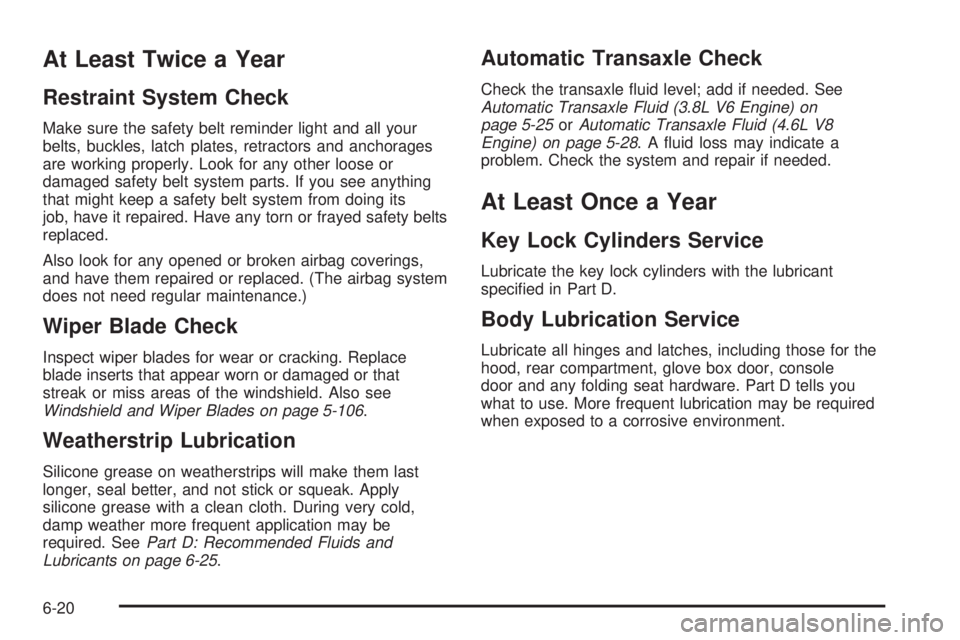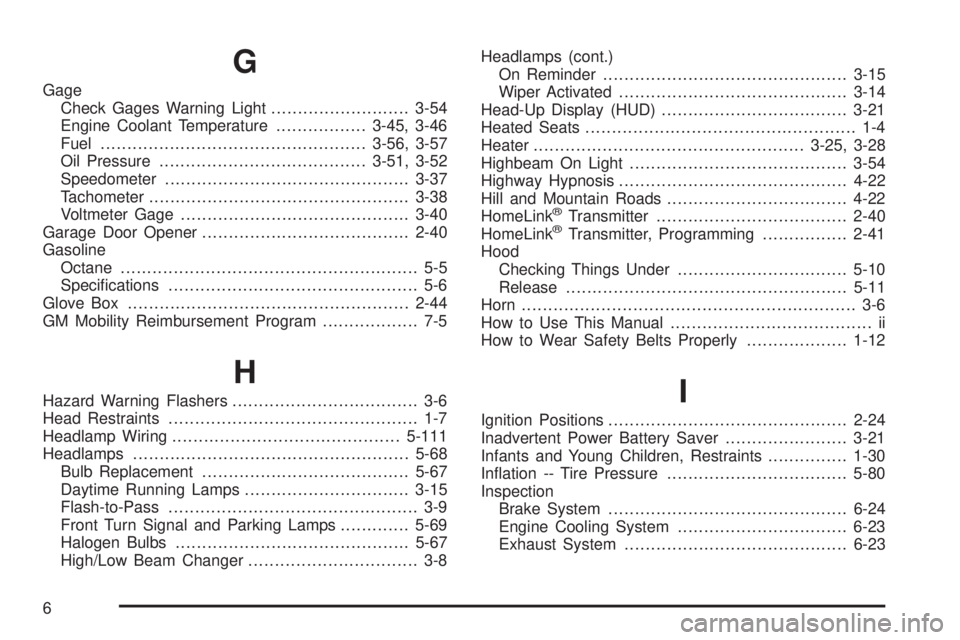Page 320 of 438

4. Open the hood on the other vehicle and locate the
positive (+) and negative (−) terminal locations on
that vehicle.
You will not see the battery of your vehicle under
the hood. It is located under the rear passenger’s
seat. You will not need to access the battery for
jump starting. The remote positive (+) terminal is for
that purpose.
Open the hood on your vehicle and �nd the
remote positive (+) terminal located in the engine
compartment on the passenger’s side of the vehicle.
Access the remote
positive (+) terminal by
removing the cover.
{CAUTION:
An electric fan can start up even when the
engine is not running and can injure you.
Keep hands, clothing and tools away from
any underhood electric fan.
{CAUTION:
Using a match near a battery can cause battery
gas to explode. People have been hurt doing
this, and some have been blinded. Use a
�ashlight if you need more light.
Be sure the battery has enough water. You do
not need to add water to the battery installed
in your new vehicle. But if a battery has �ller
caps, be sure the right amount of �uid is there.
If it is low, add water to take care of that �rst.
If you do not, explosive gas could be present.
Battery �uid contains acid that can burn you.
Do not get it on you. If you accidentally get it
in your eyes or on your skin, �ush the place
with water and get medical help immediately.
5-60
Page 324 of 438

4. Open the hoods and locate the positive (+) and
negative (−) terminal locations on the other vehicle.
You will not see the battery of your vehicle under the
hood. It is located under the rear passenger’s
seat. You will not need to access the battery for
jump starting. Your vehicle has a remote positive (+)
jump starting terminal and a remote negative (−)
jump starting terminal.
The remote positive (+)
terminal is located in the
engine compartment
on the passenger’s side of
the vehicle. Lift the red
plastic cap to access
the terminal.
The remote negative (−) terminal is located near
the power steering �uid reservoir. It is marked
“GND (−).”
{CAUTION:
An electric fan can start up even when the
engine is not running and can injure you.
Keep hands, clothing and tools away from
any underhood electric fan.
{CAUTION:
Using a match near a battery can cause battery
gas to explode. People have been hurt doing
this, and some have been blinded. Use a
�ashlight if you need more light.
Be sure the battery has enough water. You do
not need to add water to the battery installed
in your new vehicle. But if a battery has �ller
caps, be sure the right amount of �uid is there.
If it is low, add water to take care of that �rst.
If you do not, explosive gas could be present.
Battery �uid contains acid that can burn you.
Do not get it on you. If you accidentally get it
in your eyes or on your skin, �ush the place
with water and get medical help immediately.
5-64
Page 402 of 438

At Least Twice a Year
Restraint System Check
Make sure the safety belt reminder light and all your
belts, buckles, latch plates, retractors and anchorages
are working properly. Look for any other loose or
damaged safety belt system parts. If you see anything
that might keep a safety belt system from doing its
job, have it repaired. Have any torn or frayed safety belts
replaced.
Also look for any opened or broken airbag coverings,
and have them repaired or replaced. (The airbag system
does not need regular maintenance.)
Wiper Blade Check
Inspect wiper blades for wear or cracking. Replace
blade inserts that appear worn or damaged or that
streak or miss areas of the windshield. Also see
Windshield and Wiper Blades on page 5-106.
Weatherstrip Lubrication
Silicone grease on weatherstrips will make them last
longer, seal better, and not stick or squeak. Apply
silicone grease with a clean cloth. During very cold,
damp weather more frequent application may be
required. SeePart D: Recommended Fluids and
Lubricants on page 6-25.
Automatic Transaxle Check
Check the transaxle �uid level; add if needed. See
Automatic Transaxle Fluid (3.8L V6 Engine) on
page 5-25orAutomatic Transaxle Fluid (4.6L V8
Engine) on page 5-28. A �uid loss may indicate a
problem. Check the system and repair if needed.
At Least Once a Year
Key Lock Cylinders Service
Lubricate the key lock cylinders with the lubricant
speci�ed in Part D.
Body Lubrication Service
Lubricate all hinges and latches, including those for the
hood, rear compartment, glove box door, console
door and any folding seat hardware. Part D tells you
what to use. More frequent lubrication may be required
when exposed to a corrosive environment.
6-20
Page 430 of 438

G
Gage
Check Gages Warning Light..........................3-54
Engine Coolant Temperature.................3-45, 3-46
Fuel..................................................3-56, 3-57
Oil Pressure.......................................3-51, 3-52
Speedometer..............................................3-37
Tachometer.................................................3-38
Voltmeter Gage...........................................3-40
Garage Door Opener.......................................2-40
Gasoline
Octane........................................................ 5-5
Speci�cations............................................... 5-6
Glove Box.....................................................2-44
GM Mobility Reimbursement Program.................. 7-5
H
Hazard Warning Flashers................................... 3-6
Head Restraints............................................... 1-7
Headlamp Wiring...........................................5-111
Headlamps....................................................5-68
Bulb Replacement.......................................5-67
Daytime Running Lamps...............................3-15
Flash-to-Pass............................................... 3-9
Front Turn Signal and Parking Lamps.............5-69
Halogen Bulbs............................................5-67
High/Low Beam Changer................................ 3-8Headlamps (cont.)
On Reminder..............................................3-15
Wiper Activated...........................................3-14
Head-Up Display (HUD)...................................3-21
Heated Seats................................................... 1-4
Heater...................................................3-25, 3-28
Highbeam On Light.........................................3-54
Highway Hypnosis...........................................4-22
Hill and Mountain Roads..................................4-22
HomeLink
®Transmitter....................................2-40
HomeLink®Transmitter, Programming................2-41
Hood
Checking Things Under................................5-10
Release.....................................................5-11
Horn............................................................... 3-6
How to Use This Manual...................................... ii
How to Wear Safety Belts Properly...................1-12
I
Ignition Positions.............................................2-24
Inadvertent Power Battery Saver.......................3-21
Infants and Young Children, Restraints...............1-30
In�ation -- Tire Pressure..................................5-80
Inspection
Brake System.............................................6-24
Engine Cooling System................................6-23
Exhaust System..........................................6-23
6